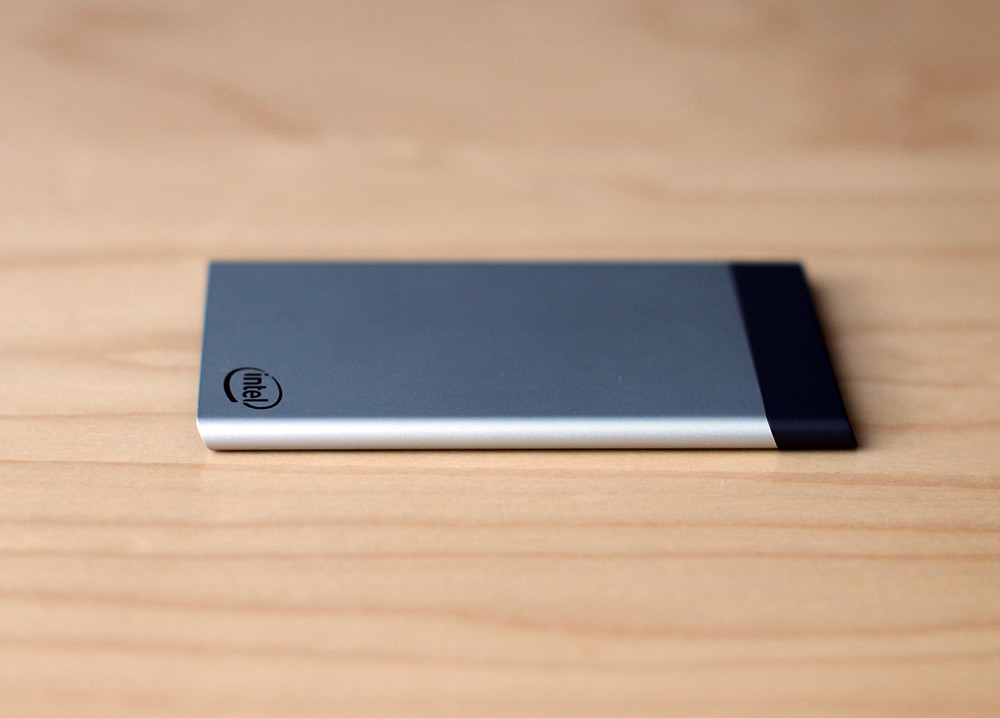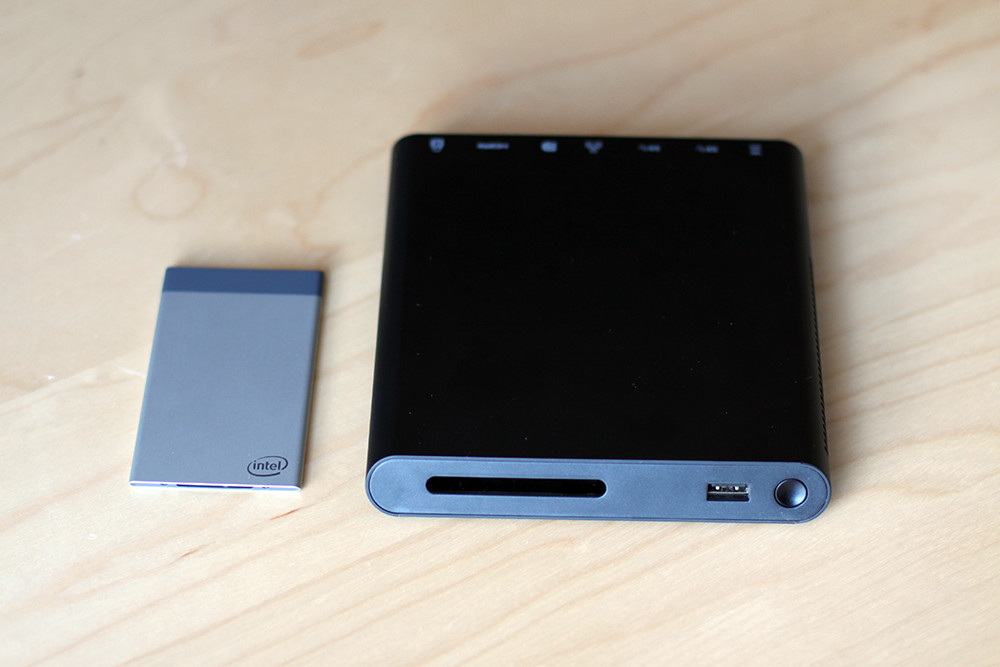The Intel Compute Card was announced at CES in January 2017 and a few months ago it began to go on sale with a remarkable feature: its unique format.
What is Intel looking for with this product? No doubt to show that there is life beyond the traditional PC. The format of the Intel Compute Card shows that it is possible to have a functional computer on a card the size of a credit card. How functional? That is precisely what we discovered in this analysis.
Specifications

In fact, the Intel offer extends to four different processors (from the Core i5-7Y57 to the Celeron N3450). We have analyzed the model with the seventh-generation Core m3-7Y30 that works at 1 GHz natively but can reach 2.6 GHz in Turbo mode. The processor has support for virtualization or Platform Trust Technology, but not for Intel vPro technology.
| INTEL COMPUTE CARD (CD1M3128MK) | |
|---|---|
| SIZE | 94.5 x 55 x 5 mm |
| WEIGHT | 1,642 kg (tablet 719 g) |
| PROCESSOR | Intel Core m3-7Y30 (Dual core at 1 GHz, 2.6 GHz in Turbo mode, 7W TDP maximum) |
| GRAPHICS | Intel HD Graphics 615 |
| RAM | 4 GB LPDDR3 1866 MHz |
| STORAGE | 128 GB PCIe x2 SSD |
| OS | Any |
| CONNECTIVITY | Wi-Fi 802.11ac, Bluetooth 4.2 |
| PORTS IN THE DOCK | Mini DisplayPort 1.2, HDMI 1.4b, GbE (RJ45), 3 x USB 3.0, Kensington lock |
| PRICE | Intel Compute Card – 335 dollars Intel Compute Card Dock – 152 dollars |
This processor is accompanied by 4 GB of RAM and 128 GB of storage in a PCIe x2 unit, but in this mini PC we also find integrated WiFi and Bluetooth connectivity thanks to the excellent Intel Wireless AC 8265, a very capable chip in this field.
In Intel, however, they do not offer a pre-installed operating system, something that forces the user to solve this section on their own. When starting the device on the screen, a message is displayed that there is no starting device precisely because of this circumstance.
We carry out the tests with a Windows 10 installation from a USB memory key, although it is also possible to install several Linux distributions which, however, do not have official support from drivers.
Intel Compute Card Dock, the other part of the equation

This docking station , which has a size reminiscent of portable CD players, is the one that offers the ports and traditional connectivity options that are the norm in PCs and laptops, and for example in the front we have the power button and off, in addition to a USB 3.0 port and the aforementioned slot for the Compute Card.
Just to the right of that slot we have an amazing digital touch button to activate the safe removal of the card, which when inserted is “trapped” by a pressure system inside the Compute Dock. Curious note: if we use the Kensington lock we will not be able to extract the Compute Card from the base station, since Intel understands that in that situation we want to avoid that option.
In the back of that base station is where we find the power outlet that we connect to the power through the adapter (19 V and 3.43 A even a total of about 65 W) of the Compute Dock. There are also the other available connection ports: two USB 3.0 ports, a Gigabit Ethernet network port, a Mini DisplayPort 1.2, an HDMI 1.4b and finally a Kensington lock.
Curiously, there is no headphone jack, and if we want to listen to audio we will have to do it on the monitors that we connect to the two types of video output with audio integrated in that base station.
The base station has two vents on its sides that allow the Compute Card to be cooled during its operation. Despite using a very efficient processor like the Core m3-7Y30 (with a modest TDP of 7 watts) the fans of the Compute Card Dock are activated often, and although the sound is not annoying, it is clearly audible.
Keep Reading: Samsung DeX: The convergence between mobile and PC is something like this
The design does not stand out, but it does not matter (too much)

That is evident in the packaging of these two solutions, which arrive in two very basic cardboard boxes in which yes, we found both these two products that combine to make that pocket computer and in the small accessories that Intel includes in the package.
So, in addition to the Compute Card and the Compute Card Dock we found four different plug adapters for different regions of the world, the power adapter and a VESA support that would allow us to attach the base station of this miniPC to the back of our monitor, for example.
The Compute Card has a really simple design that of course deceives for those who do not know this product. It almost looks more like an external storage unit or an external battery than a full computer. The aluminum housing protects the interior and also helps to promote thermal conductivity when we insert the card into the Compute Card Dock.
In one of the ends of this peculiar PC in “credit card” format we find the connectors that allow it to be coupled to the base station. Those connectors with an apparently proprietary format seem to be based on the USB-C standard in one of them, at least because of the arrangement of those internal connectors. This allows you to output all available ports in the Compute Card Dock.
Performance: This is a full-fledged (modest) PC

Do you notice a difference? Of course there are times when yes, and with somewhat heavier workloads (edit some image with Photoshop, for example) the Intel Compute Card showed its limitations. However in much of that walking the behavior of this miniPC was surprisingly smooth.
When working with several tabs in the browser while editing the text the team behaved as one would have expected from any desktop PC or mid-range laptop today. No stoppages, no conflicts, and load times that were slower than those of “real” teams were not appreciable.
That was also noticed in the synthetic performance tests. It is logical that the computer is behind many other laptops and desktop even the input range, but the figures are still remarkable for a computer that measures what a credit card.
Here one could consider the comparison with a mobile, which is certainly not much more bulky than this device and also has a screen that makes it usable at all times, but is that the Intel Compute Card goes in another direction, especially by the fact to be aimed at offering all the features of a Windows 10 computer in a super reduced format.
| INTEL COMPUTE CARD (CORE M3-7Y30, INTEL HD 615) | LENOVO YOGA 900 (CORE I7-6500U, INTEL HD 520) | INTEL COMPUTE STICK (2016) (ATOM X5-Z8300, INTEL HD GRAPHICS) | DELL XPS 13 (9343) (CORE I5-5200U, INTEL HD 5500) | |
|---|---|---|---|---|
| PCMARK HOME | 2,622 | 2,841 | 1,113 | 2,216 |
| PCMARK CREATIVE | 3.602 | 3.722 | 1.216 | 3,280 |
| 3DMARK CLOUD GATE | 3,737 | 5.472 | 1,594 | 5.180 |
| 3DMARK ICE STORM | 47,561 | 60,246 | 13,879 | 50,172 |
In the tests in fact we see how this product is comparable in those synthetic tests to a whole Mr. Lenovo Yoga 900 based on a Core i7-6500U, and even approaches a Dell XPS 13 (9343). They are both laptops from two years ago or more, but once again they are interesting references to see how far we can go with a product like this that is clearly more powerful than the Intel Compute Stick of 2016.
These results are also good in tests such as the performance of the storage unit, obviously limited by the format of this miniPC. Despite this Intel NVDSSD drive achieved rates of 758.3 MB / s in reading and 344.8 MB / s in writing, far from the next generation laptops and convertibles but certainly much higher than those offered traditional hard drives.
Geekbench 4 also demonstrated the good performance of the Intel Compute Card, which obtained 3,109 points in the Single-Core tests and 5,847 points in the Multi-Core. Remember that we are facing a micro with two nuclei at 1 GHz of native frequency and an average consumption of 4.5W that can reach 7W if we “tighten the nuts”.
The graphical power of that integrated GPU (an Intel HD Graphics 615) will allow us to play modest games with low resolutions and levels of detail, but it is clear that this solution is not designed for gaming although it does not behave badly in the graphic field despite that amazing format.
In the end, we insist, these tests show that the size deceives, and that the Intel Compute Card shows that much can be done in very little volume.
For what and for whom is the Intel Compute Card?

Formats such as Intel NUC have shown for years that it is possible to have really powerful PCs much more discrete sizes, but also surprised us while the Intel Compute Stick, an interesting approach to PCs format dongle HDMI to Despite their limited power they posed a very striking option for different scenarios.
The Intel Compute Card is another attempt to raise these alternatives. The format is surprising although it has drawbacks (the need for the Compute Card Dock makes it more expensive), but the idea that Intel presented a little over a year ago is not only aimed at the user on foot.
The proposal in fact seems to compete with other ideas that try to conquer us, and here the eternal promise of convergence could be a competitor of the Intel project. Using the smartphone as a desktop PC is something we can already do thanks to solutions like Samsung DeX.
The approximation is to a certain extent similar to the Intel Compute Card: a device that we carry in our pockets and that when connected to a cradle allows us to have a PC desktop experience. With their lights and shadows, both alternatives have a similar approach to the problem.
For the Intel Compute Card, however, the applications go further. That’s what Intel outlined in both the 2017 CES and Computex that same year.
This card could really be the “brain thinking” of products with a certain modularity: one could insert them in a refrigerator, the chassis of a robot or an All-in-One device (LG had a functional prototype about it in those demos) to have these benefits directly in these solutions.
That “dumb” desktop computer that would simply wait for the insertion of the card would have its portable version too: Nexdock already showed a laptop that was basically a chassis with screen and keyboard. When connecting the Intel Compute Card, yes, that chassis suddenly transformed into a laptop as powerful as the card itself.
These applications are interesting, in the same way that there could be many others that would make the Intel Compute Card a unique peripheral to provide the necessary hardware and software to other types of much wider solutions. Here once again Intel raises some options waiting for developers, users and industry to react, and in those we are: if this product curdles, we will see how its adoption extends to a wide variety of solutions.
Keep reading refrigerator thermostat.
